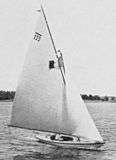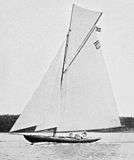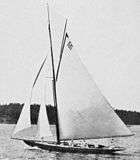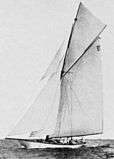Sailing at the 1912 Summer Olympics
Sailing/Yachting is an Olympic sport starting from the Games of the 1st Olympiad (1896 Olympics in Athens, Greece). With the exception of 1904 and the canceled 1916 Summer Olympics, sailing has always been included on the Olympic schedule. The Sailing program of 1912 consisted of a total of four sailing classes (disciplines). For each class two races were scheduled from 19 July 1912 to 22 July 1912 off the coast of Nynäshamn at the Baltic Sea.
| Sailing at the Games of the V Olympiad | |
|---|---|
 Yachting Bookmark in the Official Report of the Olympic Games of Stockholm 1912 | |
| Venues | Nynäshamn |
| Dates | First race: 19 July 1912 Last race: 22 July 1912 |
| Competitors | 118 from 6 nations |
| Boats | 26 |
Venue
| Royal Swedish Yacht Club | |
|---|---|
Kungliga Svenska Segelsällskapet | |
 Burgee of Royal Swedish Yacht Club | |
 | |
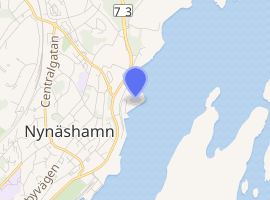
| |
| General information | |
| Type | Olympic harbor |
| Town or city | Nynäshamn |
| Country | |
| Coordinates | 58°54′30″N 17°57′30″E |
| Elevation | Sealevel |
When Sweden was assigned to host the 1912 Olympic Games two cities wanted to be the venue for the sailing program. Gothenburg and Stockholm. Gothenburg claimed that it was a much shorter passage for the oversees entries (about 525 nautical miles (972 km)) than it was to Stockholm. Stockholm however got the sailing program because of then all Olympic events should be in the same vicinity. As specific location Nynäshamn, about 60 kilometres (37 mi) from Stockholm was chosen.
The Royal Swedish Yacht Club was requested to organize the sailing event. Discussions took place whether the races would take place at the same time period of the other Olympic events. Finally the decision was taken to hold them just after the other Olympic events.[1] Also several other races were organized in conjunction of the Olympic races.
Course area
A inner and an outer course was created of the coast of Nynäshamn:
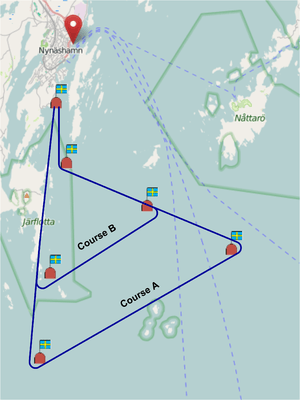
Competition
Overview
| Continents | Countries | Classes | Entries | Male | Female |
|---|---|---|---|---|---|
| 1 | 6 | 4 | 26 | 118 | 0 |
A maximum of 2 boats per country per class was allowed.
Continents
 Map of Participating Sailing Continents at the 1912 Summer Olympics ● Green = Participating for the first time ● Blue = Participating ● Light Blue = Have previously participated |
|
Countries
Source:[1]
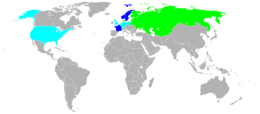 Map of Participating Sailing Countries at the 1912 Summer Olympics ● Green = Participating for the first time ● Blue = Participating ● Light Blue = Have previously participated |
|
Classes (equipment)
Source:[1] Although one of the oldest organized sporting activities, sailing in the early first part of the 20th century was not uniformly organized. This had a lot to do with national traditions as well as with the fact that there were no standardized boat types with uniform building instructions and measurements. Also a lot of development was done in the area of boat design and boat building. The shape of a boat, specifically its length, its weight and its sail area, are major parameters that determine the boat's speed. Several initiatives were started to create a formula that made it possible to have boats race each other without having to calculate the final result. But the different countries initially could not agree on an international system. At the Olympics of 1900 it was clear that sailing was not ready for international competition, and something had to be done.
In 1906 international meetings were organize to solve the problem. Finally in Paris, October 1907 the first International Rule was ratified. Delegates from this meeting went on to form the International Yacht Racing Union (IYRU), the precursor to the present International Sailing Federation (ISAF).
The agreed formula gives a result in meters (Metre). During the meeting in 1907 the IOC made the decision to open the 1908 Summer Olympics for the following Metre classes:
|
| ||||||
| Class | Type | Venue | Event | Sailors | First OG | Olympics so far |
|---|---|---|---|---|---|---|
| 6 Metre | Keelboat | Nynäshamn | 3 | 1908 | 2 | |
| 8 Metre | Keelboat | Nynäshamn | 5 | 1908 | 2 | |
| 10 Metre | Keelboat | Nynäshamn | 8 | 1912 | 1 | |
| 12 Metre | Keelboat | Nynäshamn | 10 | 1908 | 2 | |
| Legend: | ||||||
|
The 1912 Olympic Classes in action
| ||||||
Race schedule
| ● | Opening ceremony | ● | Event competitions | ● | Tie breakers | ● | Closing ceremony |
| Date | July | |||||||||||||
|---|---|---|---|---|---|---|---|---|---|---|---|---|---|---|
| 19 Fri | 20 Sat | 21 Sun | 22 Mon | 23 Tue | 24 Wed | 25 Thu | 26 Fri | 27 Sat | ||||||
| Sailing | ● ● ● ● |
● ● ● ● |
● ● ● ● |
International races | ||||||||||
| Total gold medals | ||||||||||||||
| Ceremonies | ● | ● | ||||||||||||
Medal summary
Source:[2]
Medal tables
| Rank | Nation | Gold | Silver | Bronze | Total |
|---|---|---|---|---|---|
| 1 | 2 | 0 | 0 | 2 | |
| 2 | 1 | 2 | 1 | 4 | |
| 3 | 1 | 0 | 0 | 1 | |
| 4 | 0 | 1 | 2 | 3 | |
| 5 | 0 | 1 | 0 | 1 | |
| 6 | 0 | 0 | 1 | 1 | |
| Totals (6 nations) | 4 | 4 | 4 | 12 | |
The official report used a points system to rank participating nations in the sport:[1]
| Rank | Country | Gold | Silver | Bronze | Total | ||||
|---|---|---|---|---|---|---|---|---|---|
| Medals | Points | Medals | Points | Medals | Points | Medals | Points | ||
| 1 | 1 | 3 | 2 | 4 | 1 | 1 | 4 | 8 | |
| 2 | 2 | 6 | 0 | 0 | 0 | 0 | 2 | 6 | |
| 3 | 0 | 0 | 1 | 2 | 2 | 2 | 3 | 4 | |
| 4 | 1 | 3 | 0 | 0 | 0 | 0 | 1 | 3 | |
| 5 | 0 | 0 | 1 | 2 | 0 | 0 | 1 | 2 | |
| 6 | 0 | 0 | 0 | 0 | 1 | 1 | 1 | 1 | |
| Total | 4 | 4 | 4 | 12 | |||||
Other information
- This Olympic sailing event was gender independent, but turned out to be a Men-only event.
- 6 Metre owner Dan Broström became Swedish Naval Minister from 1914 to 1917.
- The 12 Metre Heatherbell was the first 12-Metre built in the UK under the new First International Rule. She was designed by Thomas Glen-Coats, and built by Alexander Robertson and Sons Ltd (Yachtbuilders), Sandbank Scotland, in 1907.
- The Swedish 8 Metre K.S.S.S. is often referred to as the lottery boat. Obvious this boat was built from lottery funds.
Sailors
During the sailing regattas at the 1912 Summer Olympics among others the following persons were competing in the various classes:


- Danish team at the opening ceremony
- Swedish team at the opening ceremony
- Dan Broström:
Owner of the 6 Metre Kirsten  In 12 Metre:
In 12 Metre:
Halfdan Hansen In 12 Metre:
In 12 Metre:
Johan Anker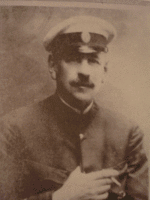 In 10 Metre:
In 10 Metre:
Esper Belosselsky-Belozersky
Further reading
- "Digital Library Collection (Official Olympic Reports 1896–2008". Digital Library Collection at la84.org. la84foundation. Missing or empty
|url=(help)
References
- The Swedish Olympic Committee (1913). Erik Bergvall (ed.). The Olympic Games of Stockholm 1912 - Official Report (PDF). Wahlström & Widstrand. Retrieved 7 February 2015.
- "Olympic Medal Winners". International Olympic Committee. Retrieved 7 February 2015.
"Stockholm 1912". Olympic.org. International Olympic Committee.

